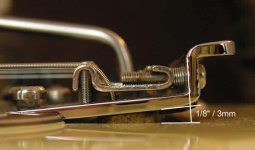squege
Active member
I just wanted to get an idea from those who have their trems setup to float, how high can you pull up in pitch? 1/2 step or a full step, or something in between?
Also, for anybody who has a trem and piezo, I know standard setup calls for non-floating to get the best performance out of the piezo, but for those of you who do setup their trems to float, how much does the piezo performance suffer and how much is the most you can set up the trem to pull up and still maintain enough pressure on the saddles to handle basic acoustic-type strumming?
Thanks, JC.
Also, for anybody who has a trem and piezo, I know standard setup calls for non-floating to get the best performance out of the piezo, but for those of you who do setup their trems to float, how much does the piezo performance suffer and how much is the most you can set up the trem to pull up and still maintain enough pressure on the saddles to handle basic acoustic-type strumming?
Thanks, JC.



